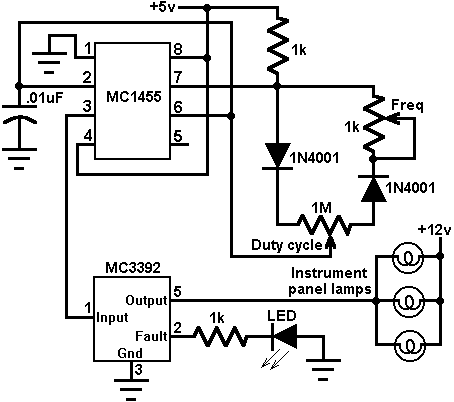Instrument panel lamp dimmer control

This circuit uses an MC3392 low side protected switch and an MC1455 timing circuit to form an automotive instrumentation panel lamp dimmer control. The brightness of incandescent lamps can be varied by Pulse Width Modulating the input of the MC3392. The modulating signal can be obtained directly from the MC1455 timer (or a microprocessor). The MC1455 is configured as a free-running clock having a frequency and duty cycle control. The typical timer frequency is approximately 80 Hz when the frequency potentiometer is adjusted to 1.0k. This frequency was chosen so as to avoid any perceptible lamp flicker. The duty cycle potentiometer controls the duty cycle over a range of about 3% to 97%. When at 3% the lamps are essentialy off, at 97% the lamps are essentially full on. Any number of lamps can be control, so long as the total load current is less than 1 amp. The LED is used to signal the existence of a system fault (overvoltage, current limiting, or thermal shutdown).
Title: Instrument panel lamp dimmer control
electronic circuit
Source: www.electronics-lab.com
Published on: 2005-02-03
Reads: 597
Print version: ![]()
Other electronic circuits and schematics from Power
-
Ni -Cd Batteries Charger
-
Portable CD Player Adapter For Car
-
High and Low Voltage Cutout with delay and Music
-
Whistle On - Whistle Off
-
Dual Regulated Power Supply
-
TTL Power Supply with вАШCrowbarвАЩ protection
-
Transformerless Power Supply
-
Self switching Power Supply
-
120 VAC Lamp Dimmer
-
13.8V 20A power supply
